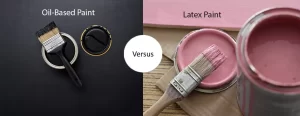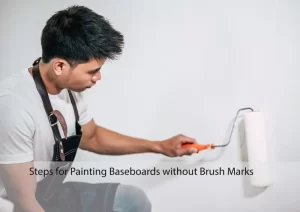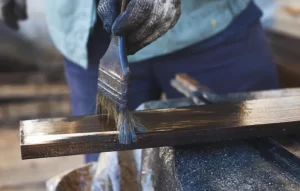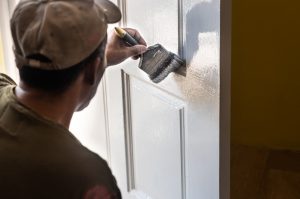It’s every homeowner’s nightmare – you’ve just painted your baseboards, and they look terrible. The paint is streaked, and there are unsightly brush marks everywhere. But don’t despair; there is a way to avoid this problem and have beautifully painted baseboards that will make your home look its best.
In this article, we’ll show you how to paint baseboards without brush marks so that you can enjoy the fruits of your labor for years to come.
The baseboards in your home take a lot of abuse. They are constantly being banged into, scuffed, and dirtied. So when it comes time to paint them, it’s essential to do the job right. Otherwise, you’ll be stuck with brush strokes and an uneven paint job that will make your home look shabby.
Paint For Baseboards:
Before we get into the nitty-gritty of how to paint baseboards without brush marks, let’s talk about the type of paint you should use. When painting any surface in your home, it’s important to use the right type of paint. This will ensure that the job looks its best and that the paint will last for years to come.
For baseboards, you’ll want to use an oil-based paint or a latex paint that has been formulated for trim.
Oil-Based Paints:
Oil-based paints have a higher level of VOCs (volatile organic compounds), which can be harmful to your health. However, they are more durable than latex paints and will resist chipping and fading better. The dry time is also longer, which gives you more time to work with the paint and avoid brush marks.
They have a strong odor, so be sure to ventilate the area well when using them. The brushmarks will be less visible with oil-based paint, but they will still be there if you don’t use the right technique.
Latex Paints:
Latex paints are water-based and have fewer VOCs than oil-based paints. They are easier to clean up and don’t have as strong of an odor. However, they aren’t as durable as oil-based paints and may not last as long. They also have a shorter dry time, so you’ll need to work quickly to avoid brush marks. Unfortunately, they also tend to show brush strokes more easily.
Regardless of which type of paint you choose, be sure to get one that is specifically formulated for trim. These paints will have a higher level of pigmentation and will go on smoother, resulting in a better-looking finish.
Steps for Painting Baseboards without Brush Marks:
Cleansing the baseboard:
Cleansing the surface is the first step in the process. If there are any grease, wax, or dirt marks, they will show through the paint no matter how many coats you apply. For best results, use a trisodium phosphate cleaner and a scrub brush to cleanse the surface. Rinse with water and allow the baseboard to dry completely before painting.
If you have new construction or if your baseboard has never been painted before, you may not need to cleanse the surface. In this case, simply sand the surface lightly with fine-grit sandpaper to create a smooth surface for painting.
Painting the Baseboard:
Now that the surface is prepared, it’s time to start painting. For best results, use a paintbrush with synthetic bristles. Start by painting the edges of the baseboard and then fill in the rest with long, even strokes. Be sure to load your brush with enough paint so that you don’t have to go over the same area multiple times. This will help avoid brush marks.
Once you’ve finished painting the baseboard, allow it to dry completely before moving on to the next step.
Applying a topcoat:
After the paint has dried, it’s time to apply a topcoat. This will help protect the paint and make it more durable. For best results, use a polyurethane topcoat. Apply it with a brush or a roller, using long, even strokes. Be sure to allow the topcoat to dry completely before walking on or touching the baseboard.
Now that you know how to paint baseboards without brush marks, you can give your home a clean, polished look that will last for years. With just a little bit of preparation and the right tools, you can achieve a beautiful, professional-looking finish.
Which Brush Do You Use To Paint Baseboards?
The brush and bristles you use to paint your baseboards can make a difference in the final look of your project. Here are some tips on choosing the right brush:
Size of the brush:
For most baseboards, a 2-inch brush will be the best size. This will allow you to get into the corners and crevices without leaving any paint behind.
Bristles of the brush :
For oil-based paints, choose a brush with natural bristles. These are less likely to leave brush marks than synthetic bristles. For latex paints, synthetic bristles are the best choice.
The shape of the brush:
An angled brush is the best choice for painting baseboards. This will allow you to get into the corners and crevices without leaving any paint behind. While you can use a flat brush, it’s more likely to leave paint behind.
Tips for Painting Baseboards without Brush Marks:
Now that you know what type of paint to use let’s get into the tips and tricks for how to paint baseboards without brush marks.
1. Use a high-quality paintbrush:
When painting any surface, it’s essential to use a good-quality brush. A cheap brush will likely have bristles that are falling out, which will result in brush marks. It’s worth spending a few extra dollars on a good brush because it will make a big difference in the quality of your paint job.
2. Use painter’s tape:
One way to avoid brush marks is to use painter’s tape along the edges of the baseboards. This will create a clean line and prevent paint from getting on the walls. Just be sure to use good-quality tape that won’t leave behind a residue.
3. Use a small roller:
Another way to avoid brush marks is to use a small roller instead of a brush. A roller will give you a more even coat of paint and will help to avoid brush marks. Just be sure to use a lint-free roller cover and to roll in one direction only.
4. Use a paint sprayer:
If you want a truly professional-looking finish, you can use a paint sprayer. This will give you a smooth, even coat of paint with no brush marks. Just be sure to practice first so that you don’t end up with paint all over the place.
5. Use a paint pad:
A paint pad is a great alternative to a roller if you don’t have one. Just be sure to use a lint-free pad and to apply even pressure as you paint.
6. Use a brush guard:
If you’re using a brush, be sure to use a brush guard. This will help to avoid brush marks by keeping the bristles from splaying out.
7. Use a foam brush:
A foam brush is another good option for avoiding brush marks. Just be sure to get one that is high quality and to use even pressure as you paint.
8. Use a hairdryer:
If you end up with brush marks, you can try using a hairdryer to remove them. Just hold the hairdryer up to the brush marks, and they should start to disappear.
9. Use a putty knife:
If the brush marks are really bad, you can try using a putty knife to scrape them off. Just be sure to go slowly and not to damage the surface of the baseboard.
10. Use sandpaper:
If all else fails, you can always sand down the baseboards and start over. Just be sure to use fine-grit sandpaper so that you don’t damage the surface.
How Do I Get A Smooth Finish On My Trim?
If you want to achieve a smooth finish on your trim, there are a few things you can do.
First, make sure that the surface is clean and free of dirt or debris.
Second, sand the surface lightly with a fine-grit sandpaper. This will help to create a smooth surface for the paint to adhere to.
Third, apply a primer to the surface. This will help to create an even surface for the paint to adhere to.
Finally, paint the trim with a high-quality paintbrush or roller. Make sure to apply evenly and smoothly to avoid brush marks.
How Do I Stop Trim Brush Strokes?
There are a few things you can do to avoid brush strokes when painting trim.
First, use a high-quality paintbrush. This will help to avoid any bristles from falling out and leaving brush marks.
Second, use painter’s tape along the edges of the trim. This will create a clean line and prevent paint from getting on the walls.
Third, use a small roller instead of a brush. A roller will give you a more even coat of paint and will help to avoid brush marks. Just be sure to use a lint-free roller cover and to roll in one direction only.
Finally, if you want a truly professional-looking finish, you can use a paint sprayer. This will give you a smooth, even coat of paint with no brush marks. Just be sure to practice first so that you don’t end up with paint all over the place.
Frequently Asked Questions:
Why does my paintbrush leave brush marks?
The paintbrush leaves brush marks because the paint is not evenly distributed on the bristles of the brush. When you dip your brush into the paint, some of the paint is left on the sides of the can or container. This causes the bristles to be unevenly coated with paint, and as you apply the brush to the surface,
Should you paint baseboards with a brush or roller?
Using a brush to paint your baseboards will give you the most control and the best finish. You can use a roller, but it is more likely to leave streaks or brush marks. If you do use a roller, make sure to use a light touch and go over the area several times to even out the paint.
How do you avoid visible brush marks when painting?
The best way to avoid visible brush marks when painting is to use a high-quality paintbrush and ensure that the bristles are evenly coated with paint.
What is the fastest way to paint baseboards?
The fastest way to paint baseboards is to use a paint roller. Paint rollers can cover a larger area more quickly than a paintbrush, and they are less likely to leave brush marks.
How do you paint molding without brush strokes?
If you want to avoid brush strokes when painting molding, you should use a paintbrush with soft bristles. Dip the brush into the paint and then tap it on the edge of the can to remove any excess paint. When applying the brush to the surface, use light, even strokes.
How do you paint baseboards like a professional?
The professionals always use a high-quality paintbrush or a foam roller to avoid brush marks. They also take their time while painting and do not try to hurry the process.
How do you refresh baseboards?
You can refresh your baseboards by painting them with a fresh coat of paint. If the baseboards are very dirty, you may need to clean them first with a mild detergent.
Should you roll or brush trim?
It is best to use a brush to paint the trim. You can use a roller, but it is more likely to leave streaks or brush marks. If you do use a roller, make sure to use a light touch and go over the area several times to even out the paint.
How can I cut without brush marks?
The best way to avoid brush marks when cutting is to use a sharp knife or razor blade. Dip the blade into the paint and then tap it on the edge of the can to remove any excess paint. When you apply the blade to the surface, use light, even strokes.
What kind of brush do you use for baseboards?
The best type of brush to use for baseboards is a high-quality paintbrush with soft bristles.
Conclusion:
To avoid brush marks when painting baseboards, use a good quality synthetic bristle paintbrush and paint in the direction of the grain. Start at the top of the baseboard and work your way down. Use even strokes, and don’t overload your brush. If necessary, you can lightly sand the baseboard before painting to create a smooth surface.
I hope this article has been helpful in showing you how to paint baseboards without brush marks. If you have any further questions, please don’t hesitate to ask.






3 thoughts on “How To Paint Baseboards Without Brush Marks?”